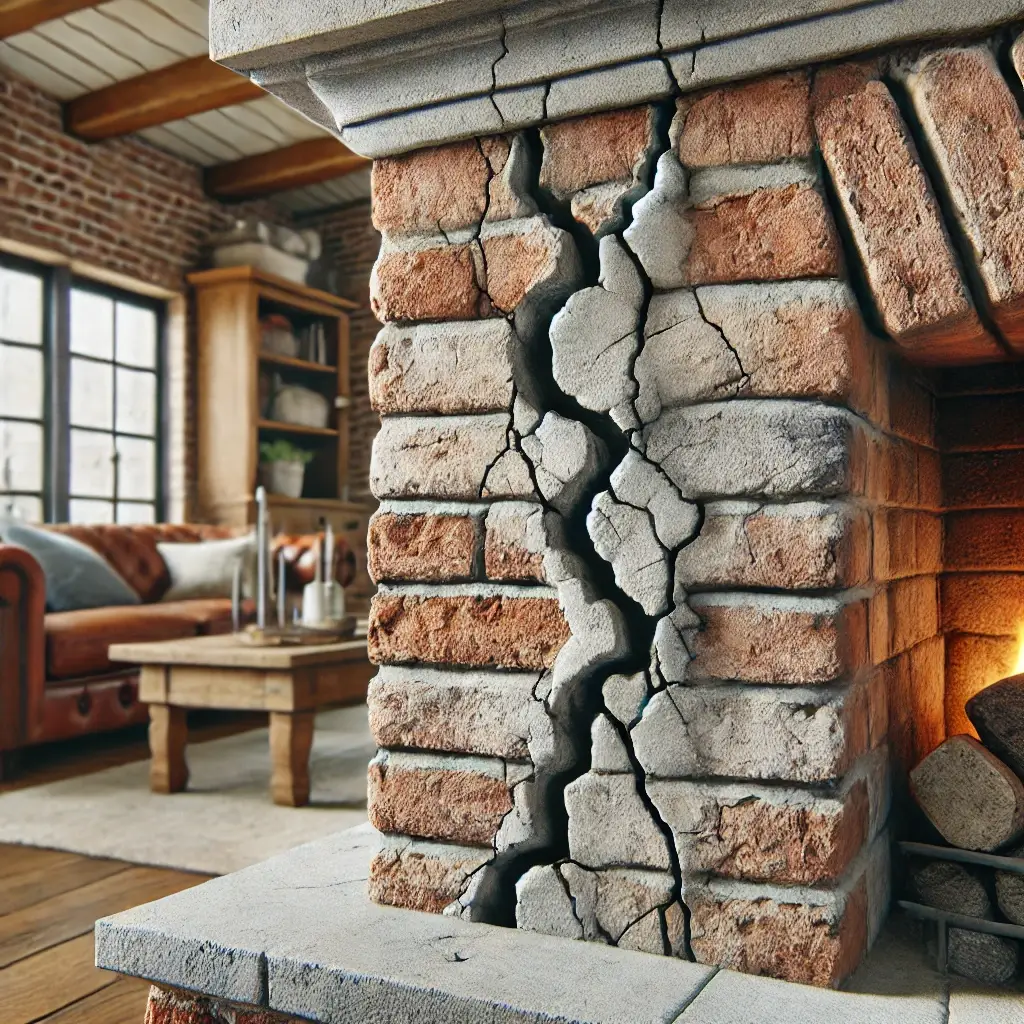A fireplace adds warmth and charm to any home, but what happens when you notice cracks forming in the structure? Is it safe to continue using a cracked fireplace, or are you putting your home at risk?
In this guide, we’ll explore the dangers of using a damaged fireplace, how to inspect and repair cracks yourself, and when it’s time to call in a professional.
Let’s dive in!
Is It Safe to Use a Cracked Fireplace?
No. Using a cracked fireplace can pose significant safety risks, and it is generally not advisable to do so without addressing the cracks. Cracks can allow flames and burning embers to escape, which increases the risk of igniting nearby combustible materials.
The fireplace cracks may facilitate the escape of harmful gases, including carbon monoxide, into your home, posing serious health hazards. Even minor cracks should be addressed quickly, as they can worsen over time and lead to more dangerous situations.
If you notice any cracks, it’s best to stop using the fireplace until a professional inspection is conducted. For minor hairline fractures, refractory caulk designed for high temperatures may be sufficient for repair; however, larger cracks require professional evaluation and repair to ensure safety.

What Causes Fireplace Cracks?
-
Repeated heating and cooling of the fireplace materials can cause expansion and contraction, leading to cracks.
-
Low-quality materials or improper installation can contribute to early wear and tear.
-
Water infiltration can weaken the masonry and cause cracking.
-
Settling of your home’s foundation may cause structural shifts that result in cracks.
Common Types of Fireplace Cracks
1. Hairline Cracks
These are thin, nearly invisible cracks that may not pose immediate structural concerns but can indicate underlying issues. They often result from excessive heat exposure, sudden temperature changes, or foundation settling.
If left unaddressed, hairline cracks can widen and compromise the fireplace’s integrity.
How to Fix
Use Refractory Caulk: For minor hairline cracks, clean the area thoroughly to remove any debris or loose material. Fill the crack with high-temperature refractory caulk, ensuring it penetrates deeply into the crack.
Smooth the surface with a putty knife and allow it to cure according to the manufacturer’s instructions
2. Vertical Cracks
Vertical cracks run up and down along the bricks and may signal significant structural issues. They can be caused by thermal expansion, moisture exposure, or poor bricklaying techniques.
Severe vertical cracks can destabilize the fireplace; thus, they require careful inspection and potentially professional repair methods such as tuckpointing or brick replacement.
How to Fix
Repointing Mortar Joints: This involves chiseling out damaged mortar and replacing it with fresh refractory mortar designed to withstand high temperatures. Clean the joints thoroughly before applying new mortar, ensuring a tight fit.
Applying Waterproof Sealant: After repointing, consider applying a high-quality masonry sealant to protect against moisture infiltration.
3. Horizontal Cracks
These cracks are particularly concerning as they often indicate serious structural problems or water infiltration issues. Horizontal cracks typically result from thermal expansion and contraction or foundation settling.
Repairing horizontal cracks may involve consulting a professional for solutions like repointing mortar or rebuilding sections of the brickwork.
How to Fix
Chisel and Replace Mortar: Similar to vertical cracks, horizontal cracks require careful removal of old mortar followed by application of refractory mortar. Ensure that the new mortar is applied evenly and allowed to cure properly.
Structural Reinforcement: In severe cases, installing helical tie bars may be necessary to reinforce the structure and prevent further movement.
4. Step Cracks
Step cracks appear in a zig-zag pattern and often indicate underlying issues related to settling or structural instability. They are significant as they can compromise the fireplace’s integrity over time if not addressed promptly.
Regular inspections by professionals can help detect these cracks early and determine necessary preventive measures.
How to Fix
Step cracks often indicate significant structural issues. It is advisable to have a qualified chimney sweep or masonry contractor inspect these cracks.
They may recommend rebuilding sections of the fireplace or using advanced reinforcement techniques
DIY Fireplace Crack Repair Tips
Materials Needed for DIY Fireplace Repairs
- Fireplace mortar
- High-temperature caulk
- Fireproof patching compound
- Wire brush
- Putty knife
- Safety gear (gloves, goggles)
1. Filling Minor Cracks with Fireplace Mortar
For hairline cracks, using fireplace mortar is a quick and effective solution. Here’s how to do it:
Materials Needed:
- Fireplace mortar (available at hardware stores)
- Putty knife
- Wire brush
- Damp cloth
Steps:
- Use a wire brush to remove any loose debris or soot from the crack.
- Use a damp cloth to moisten the area. This helps the mortar adhere better.
- With a putty knife, carefully apply the fireplace mortar into the crack.
- Once the crack is filled, use the putty knife to smooth out the surface.
- Let the mortar cure for at least 24-48 hours before using the fireplace again.
2. Repairing Major Structural Cracks
Major cracks require more intensive repairs to ensure your fireplace remains safe to use. Structural cracks might be caused by shifting foundations or water damage.
Materials Needed:
- Fireproof patching compound
- Trowel
- Wire mesh (for larger cracks)
- Safety gear
Steps:
- If the crack is wider than 1/8 inch, you’ll need to reinforce it with wire mesh.
- Remove loose debris and ensure the area is dry.
- Use a fireproof patching compound to fill the crack. If the crack is large, place a piece of wire mesh over it before applying the compound.
- Use a trowel to shape the patch so that it blends with the surrounding masonry.
- Allow the patch to dry for at least 48 hours before lighting a fire.
3. Repairing Prefabricated Fireplace Cracks
Cracks in prefabricated fireplaces can compromise the firebox panels, making them unsafe. These panels are designed to reflect heat and protect the fireplace’s outer casing from intense heat.
When to Use High-Temperature Caulk? High-temperature caulk is ideal for small cracks in prefabricated fireplaces.
Steps to Apply High-Temperature Caulk:
- Clean the crack and the surrounding area.
- Apply the caulk directly into the crack using a caulk gun.
- Smooth out the caulk with a putty knife.
- Allow it to cure for 24 hours before use.
If the refractory panels inside a prefabricated fireplace are severely damaged, it’s better to replace them.
Steps to Replace Panels:
- Remove the old panels carefully, starting with the side panels.
- Purchase replacement panels from your fireplace manufacturer.
- Install the new panels by sliding them into place and securing them with screws or clips.
When to Call a Professional for Fireplace Repairs
Sometimes, DIY repairs won’t cut it, and you’ll need to call a professional to ensure your fireplace is safe.
Signs You Need Professional Help
- Large, deep cracks that affect the chimney’s structure.
- Persistent smoke leakage or poor ventilation.
- Cracks that reappear even after repairs.
- Damaged or loose bricks in the chimney.
The cost of professional repairs varies based on the extent of the damage and the type of fireplace. On average, repairs can range from $200 to $2,000 depending on whether you need simple patchwork or major structural work.
Preventing Future Fireplace Damage
The best way to avoid costly repairs is to take preventive measures to keep your fireplace in good condition.
- Clean your fireplace after each use to prevent soot buildup.
- Remove ash regularly to prevent moisture retention.
- Inspect the chimney cap to ensure its secure and in good condition.
Schedule a professional inspection at least once a year, preferably before the start of the colder months. This ensures any damage is caught early before it becomes a hazard.
Using the right type of firewood can reduce the risk of damage to your fireplace.
- Hardwoods: Oak, maple, and birch burn hotter and cleaner, reducing soot buildup.
- Softwoods: Pine and cedar produce more creosote, which can damage your chimney.
Safety Tips for Using Your Fireplace After Repairs
Once your fireplace is repaired, follow these safety tips to ensure it remains safe for use.
- Never overload your fireplace with too much wood.
- Use a fireplace screen to prevent sparks from escaping.
- Keep flammable materials away from the hearth.
- Proper ventilation is essential to prevent smoke from accumulating in your home.
- Check the damper to ensure it’s open before starting a fire.
- Ensure your chimney is clean and free from blockages.
- Installing smoke and carbon monoxide detectors in your home is a critical safety measure.
- Place detectors near the fireplace and in sleeping areas.
- Test detectors regularly and replace batteries as needed.
FAQs
Can I use my fireplace if it has a small crack?
Yes, small hairline cracks can be safe to use, but they should be repaired promptly to prevent them from worsening.
What type of mortar should I use for fireplace repairs?
Use high-temperature fireplace mortar designed to withstand the intense heat of a fire.
How often should I inspect my fireplace for cracks?
Inspect your fireplace at least once a year, ideally before the winter season starts.
Is it safe to repair fireplace cracks myself?
Yes, minor cracks can be repaired with DIY methods. However, for major cracks, it’s best to call a professional.
How do I know if my fireplace needs to be replaced?
If your fireplace has extensive structural damage, persistent smoke issues, or fails to meet safety standards, it may need to be replaced.
Final Thoughts
A cracked fireplace can be a serious safety risk if left unrepaired. While minor cracks can be addressed with DIY methods, larger or structural cracks require professional attention.
Regular maintenance and proper usage can help prevent future damage and ensure your fireplace remains a cozy, safe feature in your home.
Affiliate Disclosure: Fireplaceadviser.com is a participant in the Amazon Services LLC Associates Program. We may earn a commission when you click on certain links on this site and purchase.

Hello!! I am Jamal Khan. I often fix my home electric heaters and gas stove problems and research the common issues in the heating units to improve my knowledge and expertise. The aim of establishing fireplaceadviser.com is to share my expertise and knowledge with my audience.












